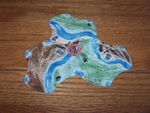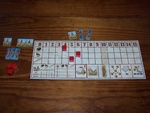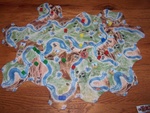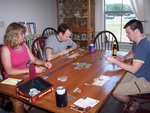
|
Bison A game by Wolfgang Kramer and Michael Kiesling Published by Phalanx Games and distributed in the US by Mayfair Games, Inc. Players: 2-4 Time: 60 minutes Reviewed by Susan Rozmiarek |

|
The combined designing talents of Wolfgang Kramer and Michael Kiesling have resulted in excellent games like Java, Tikal and Torres, to name a few. Limited actions and area majority control seem to be favored features in several of their collaborations and with Bison they have once again taken these and added new wrinkles to create another simple, elegant game.
In Bison, players take on the role of Nez Perce Native American tribes in what is now northwest Idaho. The tribes roam the land and try to establish their presence in the most fertile hunting grounds.
Components:
- 21 land tiles. Three of these are marked as starting tiles. Each tile depicts the three types of landscapes - rivers, mountain and prairie - and the corresponding animals in varying numbers - salmon, turkeys and bison. The tiles are oddly shaped with six sides that alternate curved convex and concave sides. (See pictures)
- Pieces in the four player colors including:
- hunters represented by wooden cubes
- wooden scoring cubes
- teepee tiles that have values of 1, 2, 3 or 4
- canoe tiles that have values of 1, 2, 3 or 4
- Players boards - these are used to keep track of the player's food and actions taken during the game. They also have cost charts on them for reference which is very handy.
- 16 white action cube markers
- Totem pole tile that designates the starting player
- Rules booklet -the rules are excellent and provide many illustrations and examples.
Game play:
The goal of the game is to be tribe holding the most valuable land at the end of a fixed number of "seasons."
The value of a region is measured by the number of animals it will produce each season.
The three starting tiles are placed together to form the starting board and the rest are shuffled to form a facedown draw pile. Some tiles are removed depending on the number of players.
Players start the game with a limited number of hunters, canoes and teepees. The rest are put into a market where the player can purchase them during the game. Players also start the game with 10 each of bison, turkeys and salmon. They mark this on the appropriate tracks on their player boards where they will keep track of the animals they spend and collect during the game.
The game is played in a number of "seasons" based on the number of players. The number of seasons increases with fewer players. A four-player game will be four seasons long. During each season, players each draw a tile from a facedown supply which must be played at some point in the season. Then, in turn order, they will each take four actions, one-by-one, marking the appropriate action box on their player board. This is to indicate that they have taken that action this season as each different action can only be taken once by a player each season. After all players have taken four actions, the regions are scored based on majority control as indicated by the presence of hunters, teepees and canoes. The numbers of animals pictured on the tiles in the regions formed are awarded to the appropriate players and the markers moved accordingly on their respective player boards.
The action phase is the meat of the game and involves players getting their hunters on the board and moving them around to establish majority control by building teepees and canoes in the regions formed as tiles are placed. There are six possible actions:
- Place your tile on the board and place up to 5 of your hunters on it.
The hunters must be available from your immediate supply and can be placed on only one of the terrain types on the tile.
The tile can be placed anywhere so that two sides are joined as long as the new tile is not more than three tiles away from the starting tiles.
This is the ONLY way to get hunters onto the board.
This feels a bit similar to the popular game, Carcassonne.
- Building or enlarging a teepee
- Building or enlarging a canoe
These actions both work the same way except teepees are built on mountains or prairie and canoes are built on water. To build, you must hunters on that terrain area equal to the value of the teepee or canoe, or equal to the difference if upgrading. Hunters are removed and placed back in your supply. So, if I want to build a 2-valued canoe, I must have at least two hunters on a river space. To later upgrade it to a 3-valued canoe, I must have at least one hunter on the space. Both hunter and the 2-valued canoe would go back to my supply. By building teepees and canoes, not only do you increase your influence in an area, but you also get hunters back to be placed in the next season when you play your tile.
The following three actions allow you to move hunters around the board. Teepees and canoes may never move. Each terrain type on a tile counts as one space and moving to a different tile (even if it is the same terrain type) also counts as one space. Hunters may move through a spot with an enemy hunter, but cannot stop there.
- Gathering hunters, which I call "holding a powwow." Up to five of your hunters may move from anywhere on the board to a single space containing at least one of your hunters. This can be a very powerful action, especially at the end of the game and can give an opponent a nasty surprise.
- Move up to five of your hunters one space each.
- Move up to five of your hunters 1 to 3 spaces each.
Each action has a cost in animals which is where careful resource management comes into play. The cost depends on the number of hunters involved and is the same for each type of action which makes it very easy to remember. If one hunter is involved, the action is free. If two are involved, then you must pay any two animals. Three hunters cost four animals and so on up to five hunters which costs a very expensive ten animals. The animals can be the same type or a mix. So, placing three hunters on a tile costs four animals and upgrading a 2-value teepee to a 4-value one costs two animals.
At any time during a round, a player may buy more hunters, canoes or teepees from his market if there are any available. The cost is one of each type of animal (for a total of three) for one hunter and the same for each diamond (the value) for canoes and teepees. So, a 3-valued teepee costs 3 bison, 3 turkeys, and 3 salmon, which is quite expensive. At any time, a player may trade types of animal at ratio of 3:1. The neat thing about the market cost is that if forces players to go hunt all three types of animals.
Scoring
At the end of each season, each region of each terrain type that has been formed will be scored. The scoring is similar to the game Entdecker. The player with the highest valued teepee or canoe has the most influence with ties broken by the next highest valued and then on number of hunters. This player scores the number of animals in the entire region and adds them to his food supply. With ties, each tied player receives half. The person with the second most influence gets half the number of animals rounded down. Third and fourth place players get animals equal to the number showing on the actual spaces occupied by their pieces. This can be rather interesting in that sometimes the third or fourth place player can score more than the second place player. After all regions are scored, a new season starts.
Scoring at the end of the game is somewhat different. After all players have completed their actions, they lose all the animals that haven't yet spent. Then the regions are scored as usual and the player with the most animals (adding together all three types) is the winner. This is a very interesting way to score as it encourages players to spend all their actions as efficiently as possible during the game to gain influence all the board as hoarding them gains them nothing in the final scoring.
Comments:
The placement of tiles and hunters on the board also makes for tough decisions. Do you place a tile so as to increase the animals in an area that you already control or do you place it to get hunters in a region of the board where you have none so you can compete for valuable territory there? While there is some luck in the tile draw, it didn't seem to be too big of a factor in my games.
Of course, having hunters available to place every season poses an interesting problem as you have so very few. The limited number drives players to build canoes and teepees to get their hunters off the board to place again in the next season. The few canoes and teepees that players start with will be used eventually, requiring them to buy more at the market. Hence, players will find it necessary to balance the types of resources they have available in order to do this. This need for diversity drives some of the competition on the board, making the game that much more confrontational. While a player may be tempted to spend his actions reinforcing a valuable area in which he holds a majority, he also needs to make an effort to acquire territories that have the other types of resources. It's hard to do both with a limited number of actions and animals. See how it all neatly works together? I think it is this resource management aspect that really draws me into the game.
The game works very well with both three and four players. I liked the three player game a bit better as the extra seasons make it more likely that you have the time and resources to purchase and build your higher valued pieces. Unfortunately, I have not had a chance to play it with just two although I see no obvious reason why it wouldn't work okay with that number.
While the theme is not overly exciting, it fits the game play well enough although there are a few inconsistencies like the fact that teepees and canoes are immobile. However, fans of German-style games should be quite used to this and Bison's theme fits much better than many other games of its type.
I've gotten deathly tired of area majority games and there are so many of them. Bison though, has taken some familiar (some would even say old and tired) mechanisms and created a new game in the genre that is different enough to captivate me. While some experienced gamers will find Bison to be too redundant, the resource management involved intrigues me enough to want to explore it further. For that reason, I can easily recommend it to fans of this type of game.
| Other Web information: |
This page viewed
E-mail Ed Rozmiarek with questions or problems concerning this page.
Copyright © 2006, Ed & Susan Rozmiarek. No portion of this website may be reproduced or copied without the consent of Ed or Susan Rozmiarek.




